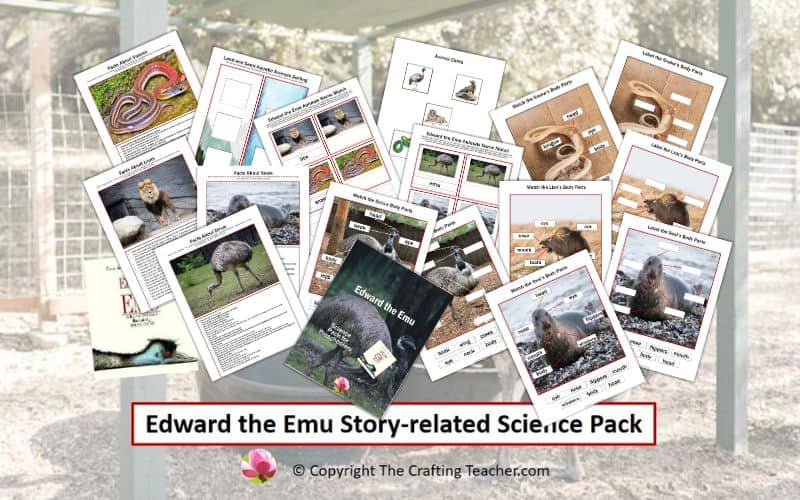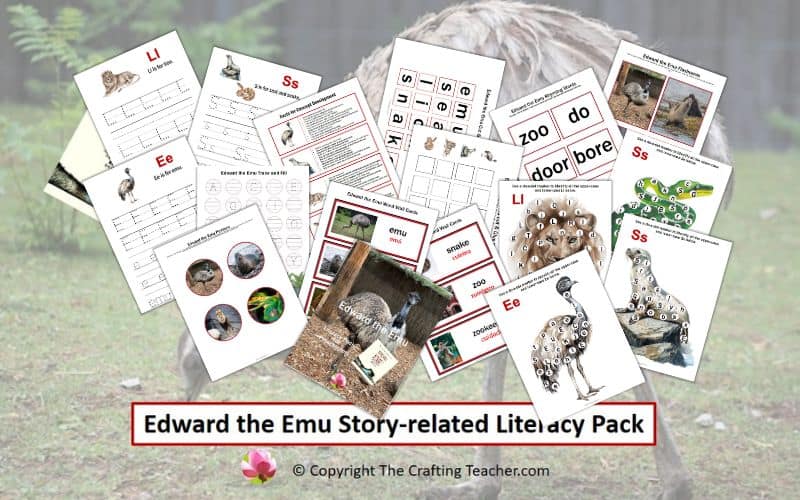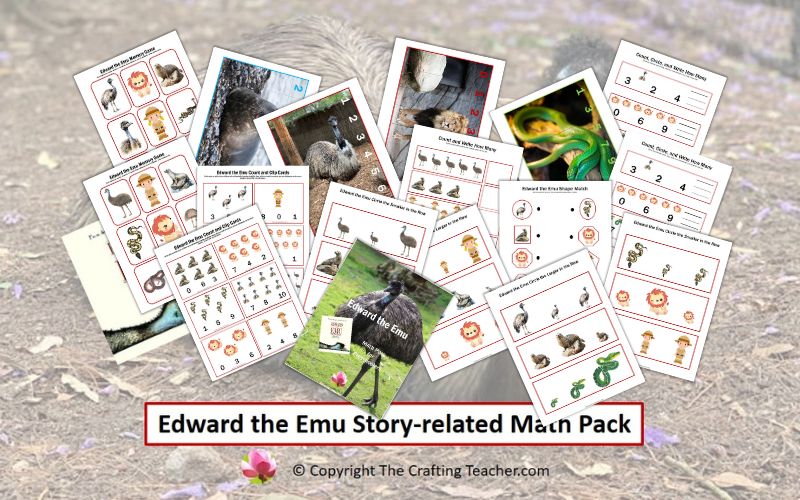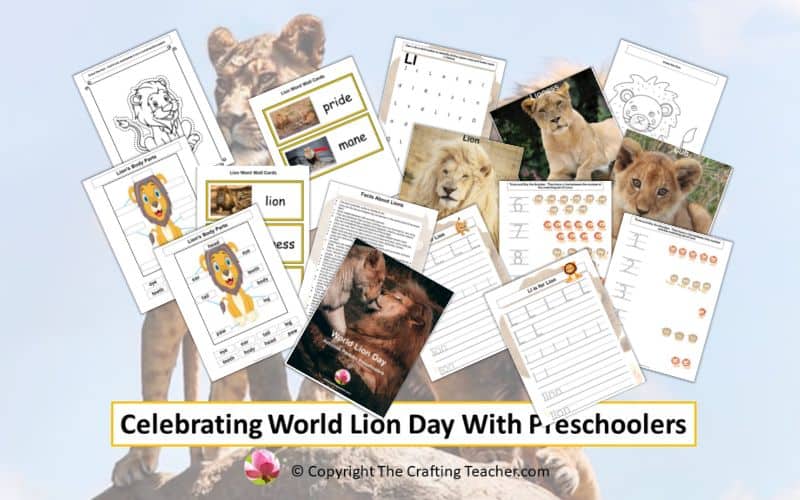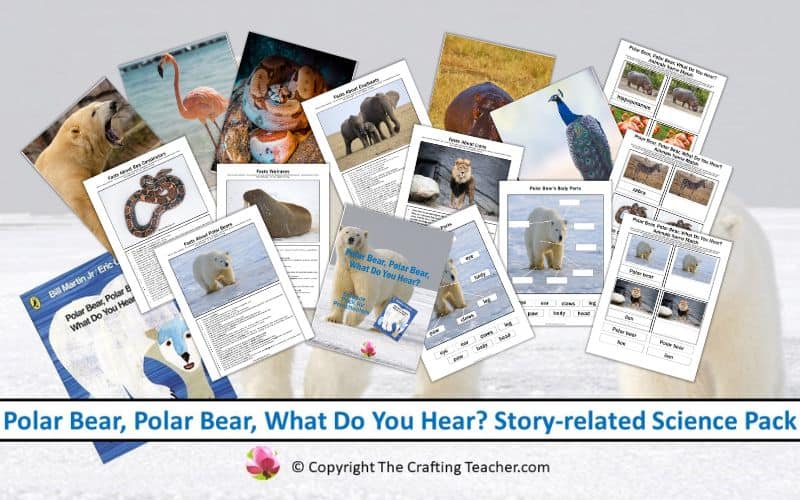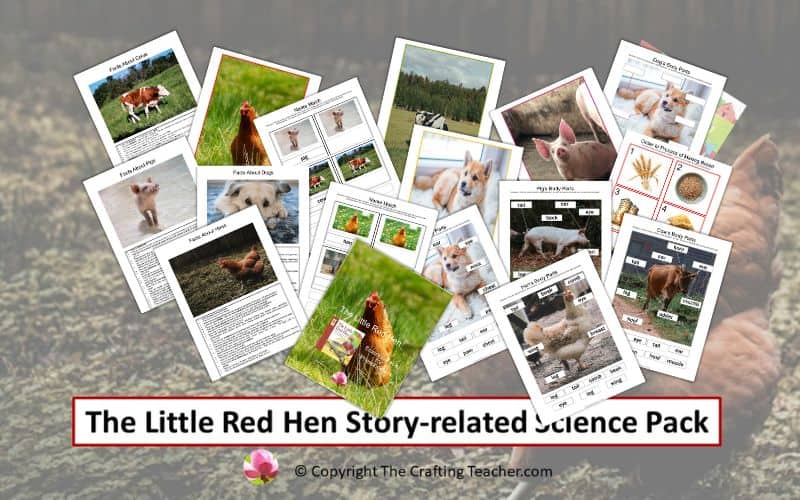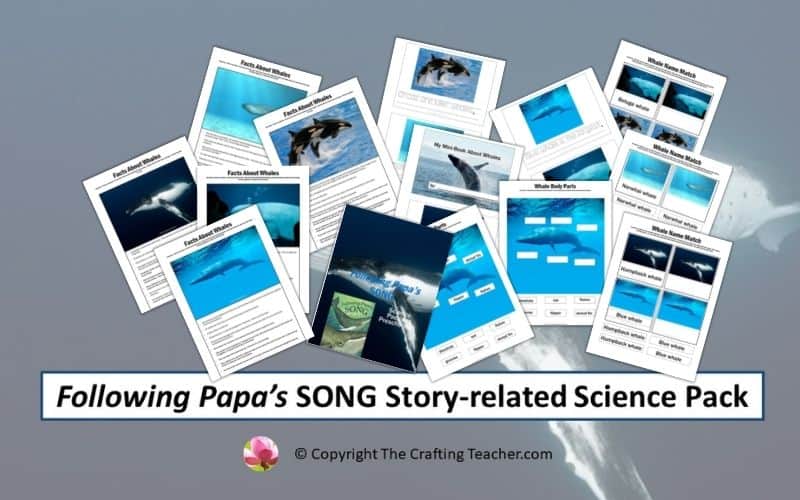Edward the Emu Story-related Science Pack for Preschoolers
Affiliate Disclosure: “This post contains affiliate links, which means I receive a small commission, at no extra cost to you, if you make a purchase using those links.”
This FREE 23-page Edward the Emu Story-related Science pack provides the perfect science activities for this story.
Edward the Emu, written by Sheena Knowles, is the story of Edward, an emu that lives in a zoo and, tired of the life he’s living, decides to try being something else for a change. He tries swimming with the seals, he spends a day lounging with the lions, and even slithers with the snakes. But Edward soon discovers that being an emu may be the best thing after all.
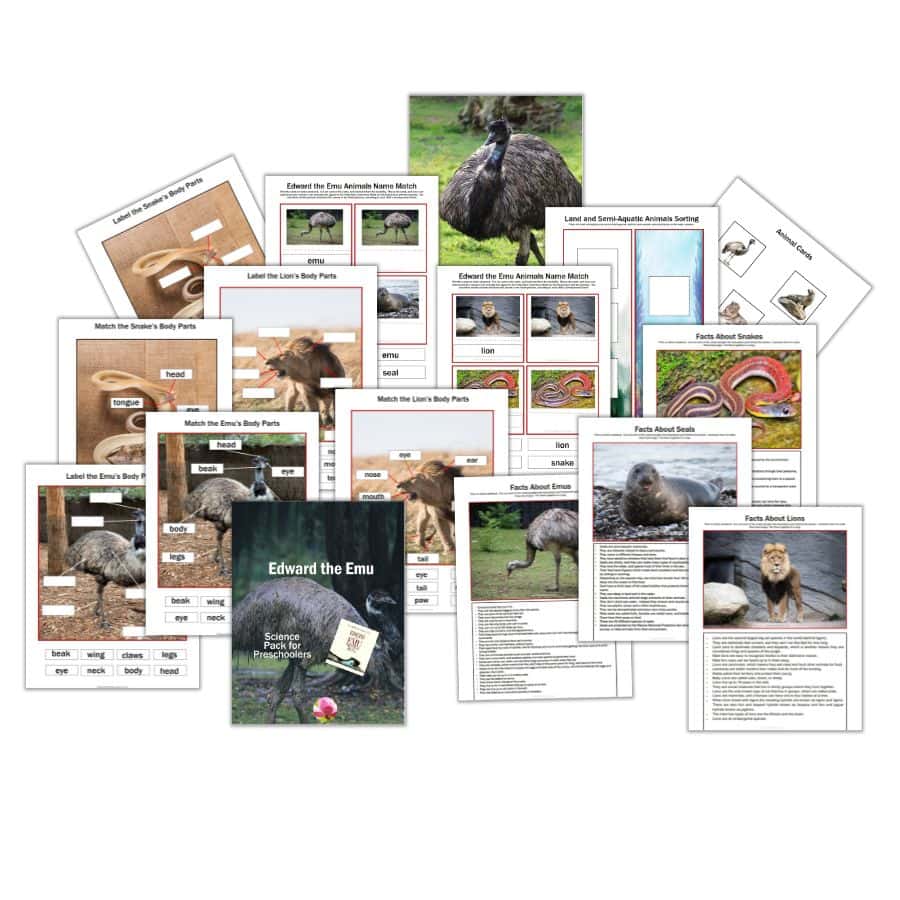
This Edward the Emu Science pack includes four different activity sets to accompany the story, helping preschoolers develop essential skills such as gathering and analyzing information, developing scientific language, attention to detail, curiosity about their world, memory, persistence, and problem-solving. You can download it at the end of this post.
Facts Cards
Teaching preschoolers facts about animals helps them develop empathy, compassion, respect, knowledge, a love of nature, curiosity, and a connection to the natural world. It helps them develop their critical thinking, social-emotional, vocabulary, and communication skills.
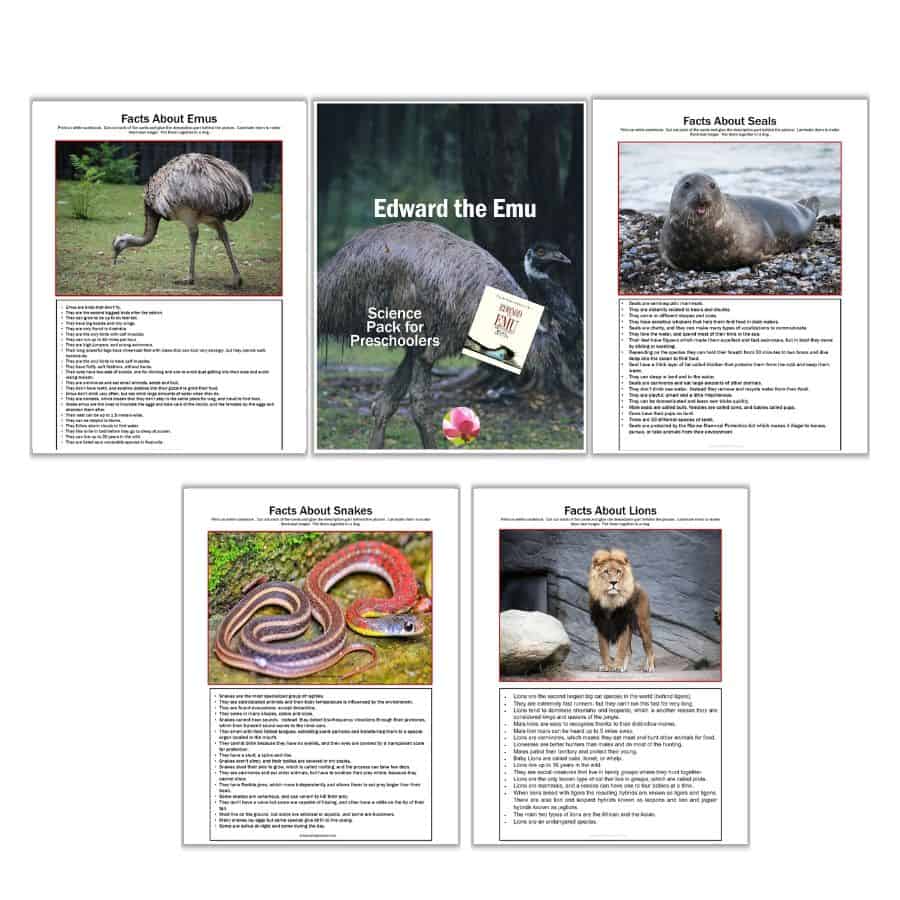
You can start by creating a KWL chart with their answers (K = what they know; W = what they want to know, and L = what they learn).
Show them toy animals and/or real pictures of the animals in the story. Ask them if they know what animal each one is and what they know about it. Write down everything they know about these animals in the K column.
Then ask them what they would like to know about the same animals, and write their answers under the W column.
At the end, when you review what they learned, write down the information in the L column. Keep it up so they can come back to it, discuss the information, and ask questions about it.
Below are some crucial facts about each of those animals.
Facts About Emus
- Emus are birds that don’t fly.
- They are the second biggest birds after the ostrich.
- They can grow to be up to six feet tall.
- They have big bodies and tiny wings.
- They are only found in Australia.
- They are the only birds with calf muscles.
- They can run at speeds of up to 30 mph.
- They are high jumpers and strong swimmers.
- Their long, powerful legs have three-toed feet with claws that can kick very strongly, but they cannot walk backward.
- They are the only birds to have calf muscles.
- They have fluffy, soft feathers without barbs.
- Their eyes have two sets of eyelids: one for blinking and one to prevent dust from getting into their eyes and causing them to lose moisture.
- They are omnivores and eat small animals, seeds, and fruit.
- They don’t have teeth and swallow pebbles into their gizzard to grind their food.
- Emus don’t drink very often, but when they do, they can consume large amounts of water.
- They are nomads, which means that they don’t stay in the same place for long and travel to find food.
- Males emus are the ones to incubate the eggs and take care of the chicks, and the females lay the eggs and abandon them after.
- Their nest can be up to 1.5 meters wide.
- They can be helpful to farms.
- They follow storm clouds to find water.
- They like to lie in bed before they go to sleep at sunset.
- They can live up to 20 years in the wild.
- They are listed as a vulnerable species in Australia.
Facts About Seals
- Seals are semi-aquatic mammals.
- They are distantly related to bears and skunks.
- They come in different shapes and sizes.
- They have sensitive whiskers that help them find food in dark waters.
- Seals are chatty, and they can make many types of vocalizations to communicate.
- They love the water and spend most of their time in the sea.
- Their feet have flippers, which made them excellent and fast swimmers, but on land, they move by sliding or scooting.
- Depending on the species, they can hold their breath from 30 minutes to two hours and dive deep into the ocean to find food.
- Seals have a thick layer of fat called blubber that protects them from the cold and keeps them warm.
- They can sleep on land and in the water.
- Seals are carnivores and eat large amounts of other animals.
- They don’t drink seawater. Instead, they remove and recycle water from their food.
- They are playful, intelligent, and a little mischievous.
- They can be domesticated and learn new tricks quickly.
- Male seals are called bulls, females are called cows, and babies are called pups.
- Cows have their pups on land.
- There are 33 different species of seals.
- Seals are protected by the Marine Mammal Protection Act, which makes it illegal to harass, pursue, or take animals from their environment.
Facts About Lions
- Lions are the second-largest cat species in the world, behind tigers.
- They are speedy runners, but they can’t run this fast for very long.
- Lions tend to dominate cheetahs and leopards, which is another reason they are considered the kings and queens of the jungle.
- Male lions are easily recognizable thanks to their distinctive manes.
- Male lions can roar up to 5 miles away.
- Lions are carnivores, which means they eat meat and hunt other animals for food.
- Lionesses are better hunters than males and do most of the hunting.
- Males patrol their territory and protect their young.
- Baby Lions are called cubs, lionets, or whelps.
- Lions live up to 16 years in the wild.
- They are social creatures that live in family groups where they hunt together.
- Lions are the only known type of cat that lives in groups, which are called a pride.
- Lions are mammals, and a lioness can have one to four babies at a time.
- When lions breed with tigers, the resulting hybrids are known as ligers and tigons. There are also lion and leopard hybrids, known as leopons, and lion and jaguar hybrids, known as jaglions.
- The two main types of lions are the African lion and the Asian lion.
- Lions are an endangered species.
Facts About Snakes
- Snakes are the most specialized group of reptiles.
- They are cold-blooded animals, and the environment influences their body temperature.
- They are found everywhere, except Antarctica.
- They come in many shapes, colors, and sizes.
- Snakes cannot hear sounds. Instead, they detect low-frequency vibrations through their jawbones, which then transmit sound waves to the inner ears.
- They smell with their forked tongues, collecting scent particles and transferring them to a special organ located in the mouth.
- They cannot blink because they have no eyelids, and a transparent scale protects their eyes.
- They have a skull, a spine, and ribs.
- Snakes aren’t slimy, and their bodies are covered in dry scales.
- Snakes shed their skin to grow, a process called molting, which can take a few days.
- They are carnivores and eat other animals, but have to swallow their prey whole because they cannot chew.
- They have flexible jaws that move independently, allowing them to eat prey larger than their head.
- Some snakes are venomous and use venom to kill their prey.
- They don’t have a voice, but some are capable of hissing, and others have a rattle on the tip of their tail.
- Most live on the ground, but some are arboreal or aquatic, and some are burrowers.
- Many snakes lay eggs, but some species give birth to live young.
- Some are active at night, while others are active during the day.
Label and Match Animals’ Body Parts
Preschoolers must learn about animals’ body parts to foster a deeper understanding about living things and what makes them unique, and how they interact with their environment laying the foundation for future science and biology learning, develop their body awareness, increases their vocabulary and language skills, and enhance their curiosity about different species, empathy and respect for animals and other living things.
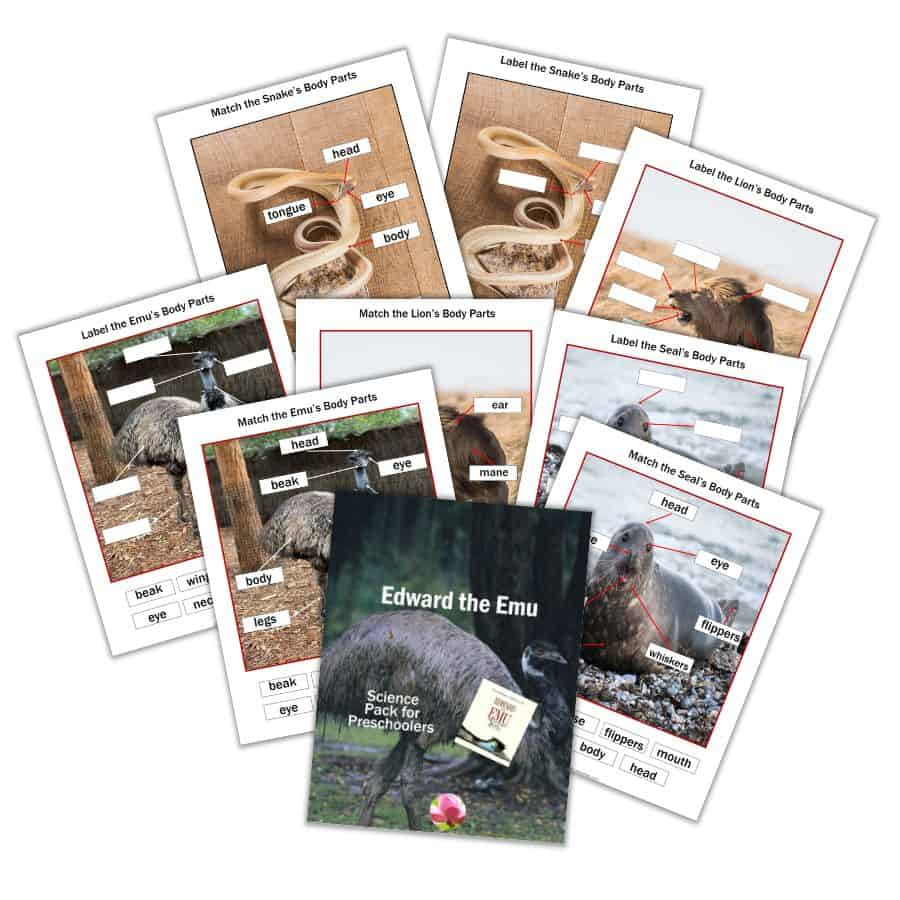
In the pack, you will find two pictures for each of the animals in the story, one with the names of body parts and the other without them. Print them on white cardstock and laminate them for durability. Add tags with the names of their body parts, previously printed on white cardstock, and laminate them as well. Put a piece of Velcro in the picture and the tags. Teach the children the names of their body parts.
Name Match Activity
Matching animal names to pictures helps preschoolers develop their vocabulary and language associating words with objects, improve their memory, concentration and problem-solving abilities, develop their fine motor skills, hand-eye coordination, and their social abilities by naming and discussing the animals, taking turns and cooperating to complete the activity, and promotes a deeper understanding and general knowledge about the natural world and its inhabitants.
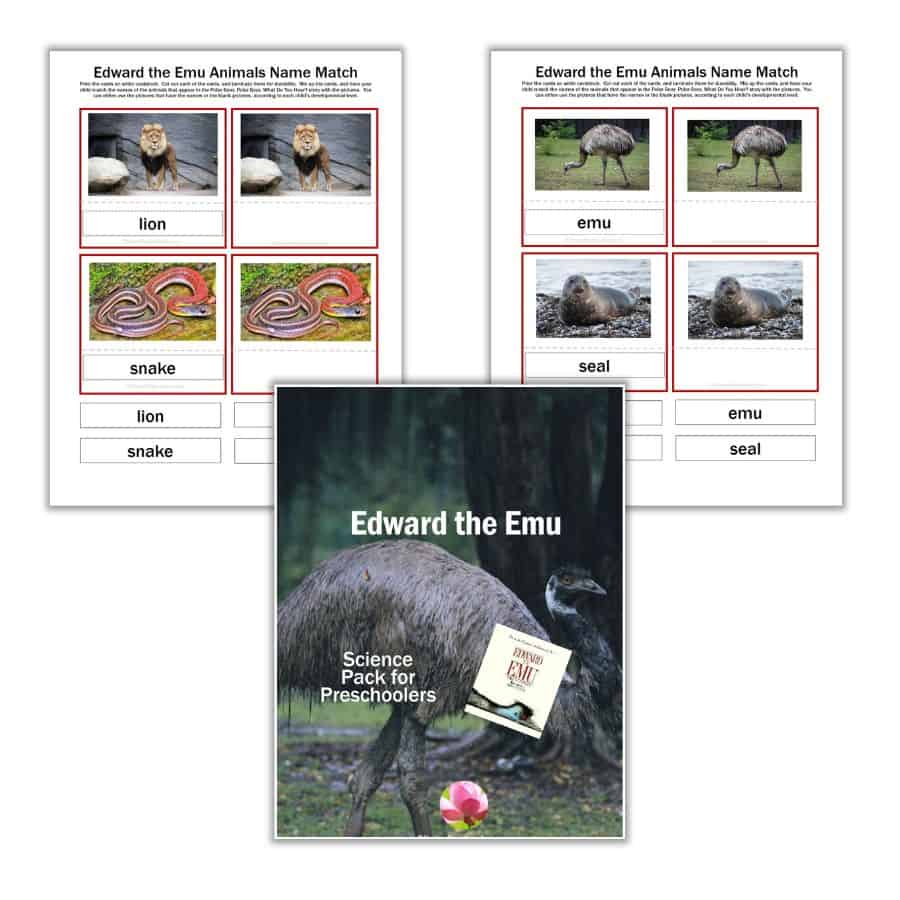
The story features four different animals, and this activity will encourage children to match their names. The activity comes with two pages, each with two sets of cards, for a total of four sets of cards. Each set has one card with the picture and name of each animal, and another card with just the image, along with labels.
Print them on white cardstock and laminate them for durability. Cut out the tags with the animals’ names, and you can also put Velcro on the cards and the tags.
Land and Semi-Aquatic Animals Sorting
This activity helps preschoolers develop their vocabulary and classification skills based on shared characteristics, while also strengthening their fine motor and problem-solving skills. This creates a deeper understanding of different animal species and their environments.
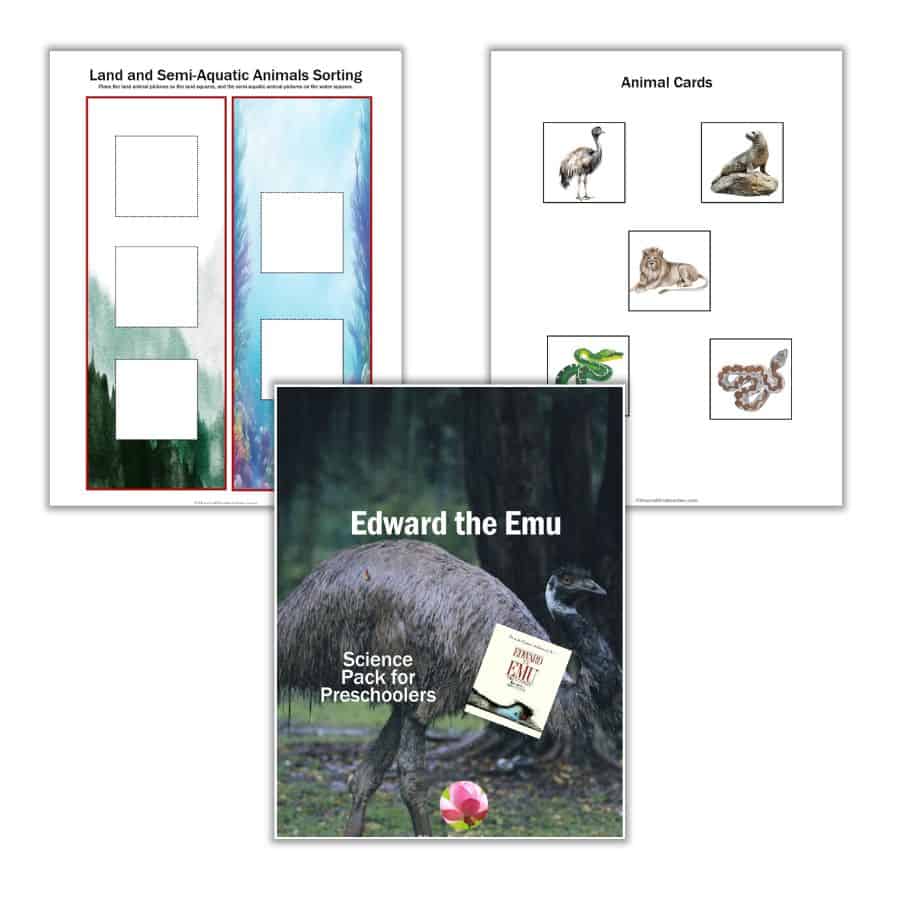
Print them on white cardstock and laminate them for durability. Cut out the tags with the animals’ names, and you can also add Velcro on the cards and the mats.
Other Ideas
- Habitats Sensory Bin – create a mini zoo and a container. Include fences, fake or real grass, a small container with water, pebbles, brushes, and toy animals (the ones that appear in the story), and invite them to recreate the story.
- Float or Sink Experiment – use your water table or a container, and the items you used in your sensory bin. Invite the children to predict which items will float and which will sink. Provide a chart paper divided into two parts: float and sink. Invite them to take one item at a time and find out if their predictions are correct. Then have them write or draw the item in the appropriate column of the chart. After they finish, discuss their findings and ask questions about their experiment, such as: “Why do you think this item was going to float/sink?”; “What happened when you tested it?”; “Why do you think that happens?”. This way, you will encourage them to develop their scientific language and stimulate their scientific thinking, problem-solving, and reasoning skills.
- Visit of an Expert – Invite a zookeeper, veterinarian, zoologist, or biologist to visit the classroom and talk to the children about various animals.
- Field trip – Organize a trip to your local zoo with your preschoolers and their families so that they can see the animals in person.
You can use these ideas on their own, but I invite you to combine them with the literacy and math activities I created for the Edward the Emu story, to take advantage of this book’s opportunity. Remember that you should not divorce literacy from math, science, or any other domain for a more comprehensive and complete educational process. They intermingle and complement each other.
Adding Books to Your Centers
Add more books about emus, seals, lions, and snakes to your library and other centers to provide children with a broad range of learning experiences and variety. These books could be an excellent source of knowledge. Below are some of my favorites. You can find these books at your local library, used bookstore, and on Amazon. The titles include my affiliate links, which will take you directly to the correct Amazon page.
- Facts About the Emu by Lisa Strattin is an educational picture book packed with facts about the emu, full-color photographs, and carefully chosen words to teach children about the iconic Australian animal.
- Emu Number Seven by Dawn Rose is a cute counting book about making friends.
- Everything You Should Know About Emus by Anne Richards will teach children facts about emus, including their color, the appearance of their feathers, and how long they have been on the planet.
- Seals! by Hope Aicher is an exciting nonfiction book that features stunning full-color photos and captivating facts about these incredible marine mammals. It reveals the unique adaptations, behaviors, and habitats of seals around the globe.
- “See What Seal Can Do” by Christine Butterworth follows a gray seal on a journey from sand to sea in an engaging, richly illustrated story that merges a lyrical narrative with fascinating facts and inspiring illustrations.
- André the Famous Harbor Seal by Fran Hodgkins tells the story of the special connection that Harry Goodridge from Rockport, Maine, has with a harbor seal pup he named André. The two became inseparable, though the seal was free to come and go as he pleased.
- All Things Lions for Kids by Animal Reads is a colorful book filled with amazing real-life images that combines fun with education to help you learn all about lions.
- Lions by Laura Marsh uses beautiful and engaging photos to teach kids all about these majestic big cats.
- Library Lion by Michelle Knudsen is the story of a lion that comes to the library one day and makes a comfy backrest for the children at story hour. But when something terrible happens, the lion quickly comes to the rescue in the only way he knows how.
- All Things About Snakes by Animals Reads is a colorful book filled with amazing real-life images that aims to combine fun with education to help you learn all about snakes.
- Snakes for Kids: A Junior Scientist’s Guide to Venom, Scales, and Life in the Wild by Michael G. Starkey is filled with fascinating facts and wild photographs that will take you close up to serpents, their habitats and life cycles and their relationships with other animals create balance in the food web and help keep ecosystems healthy.
- Oh No! There’s a Snake in the Lake by Adam Ellison is an engaging and educational story that encourages bravery, curiosity, and a love of nature using fun rhyming verses and colorful illustrations to tell the heartwarming adventure of a little girl who learns to face her worries and discovers the wonders of lake life along the way.
Pin It For Later
If you’re in a rush and don’t have time to read the post and download the printable, but you want to save it for later, pin it to one of your Pinterest boards.

Don’t forget to download your FREE Edward the Emu science pack. Just click the button below, and type your information for an immediate download.
Be happy, safe, and creative. I wish you well.
Love,

P.D. Please let me know if you like any of these ideas, or if you’d like to see something else as well. My goal is to help you in any way I can.

